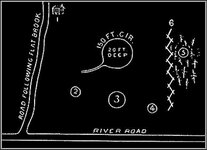"A straggling Indian, who was passing up the Susquehanna, had told of buried treasure. Joseph, hearing of this, hunted up the Indian, and induced him to reveal the place where it was buried. The Indian told him that a point, a certain number of paces due north from the highest point of Turkey Hill, on the opposite side of the Susquehanna River, was the place. Joseph now looked about for some man of means to engage in the enterprise. He induced a well-to-do farmer by the name of Harper, of Harpersville, N. Y., to go in with him".
More Info Here
http://www.olivercowdery.com/smithhome/1873Susq.htm
More Info Here
http://www.olivercowdery.com/smithhome/1873Susq.htm






 I
I  Thanks good buddy Jose, you know sometimes a kind word goes a long ways. I don’t believe for a moment though, that I have put more work into this book project than you put in to find Tayopa – I’ve seen that country and even without having to pore through ancient Spanish and Mexican archives, just hiking IN is a terrific test of your mettle! I do hope (and honestly believe that you will succeed) in getting Tayopa up and running again, and soon too! I will send you a copy of the book too, gratis.
Thanks good buddy Jose, you know sometimes a kind word goes a long ways. I don’t believe for a moment though, that I have put more work into this book project than you put in to find Tayopa – I’ve seen that country and even without having to pore through ancient Spanish and Mexican archives, just hiking IN is a terrific test of your mettle! I do hope (and honestly believe that you will succeed) in getting Tayopa up and running again, and soon too! I will send you a copy of the book too, gratis. I do believe they were Roman but at the time I knew NOTHING about them. I think I may have used one to demonstrate electrolysis to my class.
I do believe they were Roman but at the time I knew NOTHING about them. I think I may have used one to demonstrate electrolysis to my class.  ? University of Wisconsin Stevens Point if you're interested.. they are probably still there if nobody has walked off with them.
? University of Wisconsin Stevens Point if you're interested.. they are probably still there if nobody has walked off with them.



